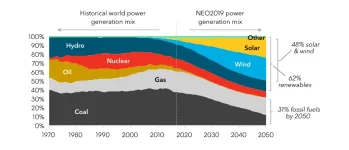Chad86tsi
Active member
- Joined
- Feb 27, 2019
- Messages
- 479
- Reaction score
- 270
- Points
- 63
- Genesis Model Type
- 2G Genesis Sedan (2015-2016)
I’ll refer you to the graph I posted earlier. Note the cost by location from ultra-low cost regions (Chile, middle east) to high cost locations. The world is passing 1000 GW cumulative installed this year, giving us $.01 to $.02 per kwh installed in the best locations. When the sun is half that costs roughly double. That’s everywhere from the yellow region up below.
View attachment 37964
3x more expensive is in the greens, which would be in the ~$.06 per kWh range today— filling up your 300 mile tank for $5.40. Now add wind, which is in the $3.60 per “tank” range and also falling, and happens to often do well in places and at times solar doesn’t:
View attachment 37965
View attachment 37966
Currently there are few incentive systems in the US for people to use power when it’s cheapest. That’s changing, and with it demand will begin to follow generation rather than vice versa. There are limited technologies to facilitate this so far, but that’s also changing. The new F150 lightening for example not only lets you charge with cheaper power but it actually lets you discharge to power your entire house when power is expensive. Industrial heat (~25% of world energy use) will flip to electric and be a swing batter, powering from electric when it’s cheap and gas when it’s not, largely eliminating seasonality as a major obstacle to high renewable fractions in the process. All enabled and indeed triggered by energy far cheaper than what’s come before.
No one said the revolution is over- we’re still in the early stages. Just that the technology that we’re evolving to already exists and the writing’s on the wall. Ice will remain in some long haul applications into the 2030s, but economics dictate that the vast majority of passenger cars will be EV and soon. Currently EVs are more expensive to buy than ICE cars but cheaper to run. That’s expected to change by 2025- EVs will be both cheaper buy and much cheaper to run, radically so with a little flexibility on when you charge. From there it’s over, though obviously the fleet and lineups will take time to turn.
I love ICE cars and you’ll pry my GT3 engine from my cold dead hands. Unfortunately there’s simply no way they’re surviving this energy revolution in substantial numbers. I just hope the specialty cars (especially the few actually more enjoyable to drive than EVs) will be around for a while.
It doesn't matter what the cost is, it matters when people use it and where is the supply and where is the demand. When do people charge their cars? When is the sun out? That it becomes cheap in the middle of the day in some sunny places does little for most of us that don't live in sunny places, and/or work 8-5 and use our cars to get there and are forced to charge at home at night when carbon generation peaks. Solar will continue to grow, and serve load. It won't make EV cars more green in most cases as we sell more of them and make more solar supply.
I'm in a yellow zone in your solar radiation map. My city officially has 144 sunny days a year, and they are not conveniently every other day so I can plan ahead. That leaves 221 days a year that are not sunny. How will my EV be charged buy the sun in November? "It won't" is the correct answer. Thank goodness we have other sources that can be ramped up in a matter of minutes on demand (carbon). This carbon supply isn't going away, and solar is going to saturate the market and achieve diminishing returns in many markets in which it works well. Carbon will power EV's for a long time, regardless of how much solar we can make.










